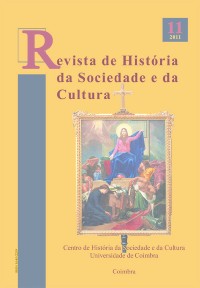Please use this identifier to cite or link to this item:
https://hdl.handle.net/10316.2/39476| Title: | A charola templária de Tomar: Jerusalém perdida | Authors: | Santos, Carlos Emanuel Sousa | Keywords: | Charola of Tomar;Jerusalem;Holy Sepulchre;Temple of Salomon;Charola de Tomar;Jerusalém;Santo Sepulcro;Templo de Salomão | Issue Date: | 2011 | Publisher: | Centro de História da Sociedade e da Cultura | Abstract: | A Ordem do Templo teve as suas raízes no Oriente, com o objectivo de prestar auxílio
aos peregrinos que se dirigiam à Cidade Santa, e aos seus respectivos espaços de culto.
Portanto, os cavaleiros do Templo entraram em contacto directo com estes lugares e o Santo
Sepulcro, Túmulo de Cristo, e a Cúpula do Rochedo foram os mais significativos. Não tardou
que realizassem em vários sítios réplicas destas construções, para fazer relembrar estes
sagrados monumentos. Ao construir templos que fizessem relembrar os espaços santos de
Jerusalém, os crentes escusavam de viajar em peregrinação à Cidade Santa porque estes eram
vistos como o próprio túmulo de Cristo, tendo todo o sentido numa Europa “dominada pela
fé”. Por ser considerado o moimento de Cristo, o Santo Sepulcro foi, variadíssimas vezes,
concebido como o centro do mundo durante os séculos XII e XIII e em raros casos no
séc. XIV. A cidade de Tomar e a sua Charola acabam por ser um reflexo disso mesmo. The Order of the Temple had its origin in the East, with the objective of giving assistance to the pilgrims who headed to the Holy Land and the respective worshipping places. Therefore, the Knights of the Temple had direct access to these places of which the Holy Sepulchre, Jesus’ Grave, and the Dome of the Rock were the most significant. Soon after, reproductions of these constructions were built in many different places, to remind people of these sacred monuments. By reconstructing temples that reminded people of the sacred places of Jerusalem, the faithful did not have the need to make sacred journeys to the Holy Land once these were seen as the Holy Sepulchre itself, which made complete sense in a Europe “dominated by faith”. Being considered the moiment of Jesus Christ, the Holy Sepulchre was many times seen as the centre of the world during the XII and XIII centuries and sometimes during the XIV century. The city of Tomar and its Charola are considered to be a reflexion of all this. |
URI: | https://hdl.handle.net/10316.2/39476 | ISSN: | 1645-2259 2183-8615 (digital) |
DOI: | 10.14195/1645-2259_11_2 | Rights: | open access |
| Appears in Collections: | Revista de História da Sociedade e da Cultura |
Files in This Item:
| File | Description | Size | Format | |
|---|---|---|---|---|
| a_charola_templaria_de_tomar.pdf | 7.83 MB | Adobe PDF |  |
Items in DSpace are protected by copyright, with all rights reserved, unless otherwise indicated.
